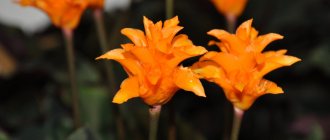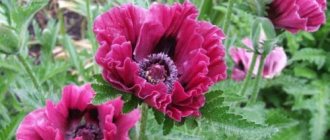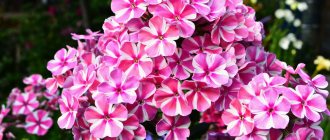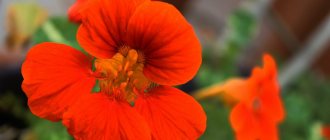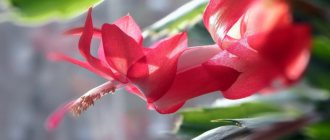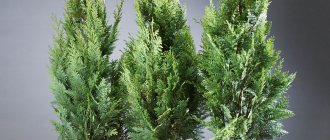Some gardeners prefer to decorate their garden plots in any one color and its shades. Among them there are also those who are most impressed by the color pink or its various tones. Let's consider the main annual and perennial plant species and varieties that are most suitable for decorating a flower bed or flower garden in this range of shades.
brandushka are among the first to appear in early spring.
(Bulbocodium). Each bulb produces several buds in the spring before the leaves grow, then two or three more flowers bloom during the summer.
Almost simultaneously with the brandushka, the colchicum
, having pink funnel-shaped inflorescences and wide leaves.
Chionodoxa
(variety “Pink Giant”) - low-growing (up to 15 cm tall) spring plant; Blooming in April, perennial varieties bloom for 3-4 weeks.
the kandyk begins to bloom
(Erythronium). When decorating a garden in pink, perennial flower varieties with such big names as “Pink Perfection” and “Rose Beauty” are ideal.
A large number of small flowers, collected in panicle-shaped inflorescences, bloom on bergenia (bergenia)
among the rounded leaves that winter under the snow.
Large pink (up to 6-7 cm in diameter) hellebore
varieties named "Gertrude Flober", "Roseus Superbus" and "Hans Schmdt". Flowers of these species bloom already in April-May.
A bushy spherical plant up to 1.5 m high, begins to bloom simultaneously with the unfolding of the leaves. Single pink inflorescences with a juicy color have blooming flowers up to 2.5 cm in diameter and look like a floating cloud for up to 2 weeks, surprising with their beauty and tenderness (see photo of almond flowers).
Recently, a variety of three-lobed almonds with a trunk height of up to 3 m, having rich pink flowers that are densely located along the entire length of the shoots, has become increasingly popular. Flowering begins in mid-May, its maximum duration is 20 days. Ornamental garden varieties of almonds, which also produce rather large fruits, are still relatively rarely used by gardeners.
(variety “Phlox Subulata”) begins flowering in May, forming rather dense thickets of creeping shoots with numerous pink flowers. With careful care (timely watering and fertilizing, sufficient sunlight), phlox can bloom again in the fall.
Among phloxes, garden varieties of paniculate phlox “Inspiration” and “Elenka”, which have large pink flowers in a light color scheme, are also suitable for a garden in pink tones.
Tulips
garden roses begin to bloom in May, but, unfortunately, the flowering period does not last long. By planting late annual varieties of double tulips (the “Angelique” variety with pale pink flowers is shown in the photo), you can extend the flowering of a flower bed or flower garden until the end of May.
Peony
It also blooms in May-June, but its flowers are very demanding of bright sunlight. The variety “Reine Elizabeth” is ideal for decorating a garden in pink tones; it blooms with large double inflorescences up to 20 cm in diameter. Careful care of the plant allows you to get up to a hundred buds on a stem 0.8 m high.
False sedum
blooms together from May until almost the end of summer; its pink flowers among green succulent leaves look like corymbose inflorescences (see photo).
The lily of the valley can delight you with its flowering
variety "Rosea", which stands out among other varieties with unusual pink flowers (see photo).
Daisies also begin to bloom in May.
- perennial (biennial) garden flowers that do not require careful care. Having planted the “Rose” variety, you can admire large double inflorescences of a light pink hue (the diameter of the flowers reaches 5-6 cm) until the end of summer (see photo).
It is advisable to divide the bushes of biennial daisies with the onset of summer. The plant easily tolerates transplantation, takes root quickly and painlessly, and continues flowering.
Roses
— among the huge number of varieties, you should pay attention to the winter-hardy variety “Maiden's Blush” with double flowers. They have various pink shades and a fragrant aroma. The variety “Mrs. John Laing" has very large buds and blooms profusely for a long time. Remontant types of roses are characterized by secondary flowering before autumn, although the re-blooming of flowers is less friendly than in summer (see photo below).
To decorate the garden, you can successfully use climbing garden varieties of roses of a pale pink shade “New Dawn”, plants with large fragrant double flowers “Conrad Ferdinand Meyer”.
A true decoration in May for a flower bed or alpine hill in the garden will be the Saxifraga arendsii variety with flowers of a dark pink hue, and the low mossy saxifrage variety Elf will stand out effectively among other plants with its abundant flowering.
Rhododendron small-leaved
- an evergreen bush up to 60 cm high, has small pink flowers located on the branches in small groups of 3-5 pieces.
(variety Rosea Flore Pleno) is a wonderful decoration for the garden. Hawthorn looks very good in a single planting, but hedges made from it look more picturesque. At the end of flowering at the beginning of summer, the hawthorn hedge may already be strewn with large red berries, very rich in vitamins (as in the photo below). Hawthorn berries are successfully used in the treatment of certain diseases.
Decorative plum
, very popular in Europe, unfortunately, in Russian gardens it is still considered an exception. In fact, the term “ornamental plum” brings together into one group ornamental garden trees such as almonds, cherries, cherries, thorns, etc. Referring to different types of plants, they are united together according to their functional purpose - to decorate the garden with their colorful blooms.
The size of the tree flowers reaches 5 cm in diameter. In addition to tree-like varieties of decorative plums, there are also shrubby varieties that are widely used for decorating and creating hedges. Ground cover species are used in the construction of rock gardens and flower beds. All of the above plants are quite unpretentious and can easily become a true decorative addition to the garden.
Weigela blooms in summer
- its pink inflorescences are similar in shape to tubes. The plant has decorative leaves edged in white. The compactness of this shrub also attracts many gardeners with its ease of care.
Iris
- if you can purchase a rather rare variety of iris “Pink Talkum” with unusually beautiful pink inflorescences, these annual beautiful flowers will certainly become the pride of your garden plot during its flowering periods (see photo). This variety, although it is an annual, can bloom several times during the season.
Dahlias are a must in a rose garden.
annual or perennial. Names such as “Promotion”, “Rose Tendre” and “Rose Preference” are familiar to many gardeners. Thus, the variety “Carried Angel” with huge inflorescences of bright pink color will delight you with delicate pink flowers of simply gigantic size (the diameter of the inflorescences reaches 22 cm), “Rose Tendre” has light pink inflorescences with a diameter of up to 17 cm, which bloom on a rather long stem. Dahlias of the “Rose Preference” variety have rich pink flowers (bud diameter is 12 cm).
The opposite of “Carried Angel” is the variety “Rose Effect” - the size of the inflorescences of this variety is up to 6 cm in diameter, the bright flowers number up to 20 buds on one plant. In such cases, by skillfully combining the sizes and shades of flowers, you can achieve very interesting and original effects when decorating a flower bed or flower garden.
Perennial unpretentious lupins
, which begin to bloom at the very beginning of summer and bloom again in August, collected in beautiful inflorescences with buds in the form of candles, will certainly become a stylish decoration of your garden (variety “Monsieur Alexander”).
Carnation
It blooms, as a rule, in summer (June - July). Garden varieties such as “Desdemona” and “Pomegranate” and Turkish carnations “Rosakonigin” with large (up to 5 cm in diameter) flowers that have a pleasant aroma are ideal for decorating a garden in pink tones.
Mallows are often planted in gardens
— the best garden decoration in the selected range of pink shades here will be the “Terry Pink” variety. The plant forms voluminous pink inflorescences on stems up to 1 m high (the size of the flower in the form of a hemisphere reaches 12 cm in diameter).
Petunia is considered one of the favorite flowers among gardeners.
(see photo). Very popular annual varieties with delicate pink flowers “Karmin Queen”, a new hybrid “Cherry Tart”, blooming with bright pink flowers up to 6.5 cm in diameter.
Summarizing this brief review of pink ornamental plants, we should note the frost-resistant ornamental cabbage
, unfortunately, almost never found in our gardens. Rosettes of large leaves, painted in bright pink and fawn colors, look great in mixborders and rock gardens in late autumn, at a time when almost all the plants in the garden have already bloomed.
The surest way to give your site freshness, to make it truly spring and light, is to plant pink flowers in its flower beds. The names of such plants with a brief description will be presented in the article below, but it should be noted in advance that among them there are both single flowers and bushes, and even trees. Also, pink representatives of the flora can be annual or long-lived. Take this into account when designing your site.
The pink flower is a characteristic feature of the perennial plant Brandushka. These tuberous bushes begin to bloom in mid-April, and delight the eye with such beauty almost until the end of summer. Following the brandushka, they appear in the colchicum - its closest relative. They look like small, almost lilac stars that can be planted throughout the area to create a magical spectacle.
Phloxes have incomparable beauty. Their long stems are literally strewn with bright pink flowers that do not fade for two months. It is easy to form a flower carpet from them, since they always grow close to each other. If phloxes are properly cared for, they will bloom in the fall.
Stunning pink flower - tulip. As a rule, it pleases the eye only in the spring, starting in March. At such a time, pink with a blue bottom or pink with silver edges may bloom in your flowerbed. Closer to May, a terry pale pink variety will become a worthy decoration of the flowerbed.
Among the most common plants that are characterized by this delicate color is lilac. It blooms by the end of May, and with proper care does not lose its small flowers for another month. In any garden, lilacs will be an excellent alternative to small fences.
Perhaps the most charming, and at the same time simple, pink flower is the daisy. Among them there are terry varieties and winter-hardy ones; with large flowers and very small, dwarf ones, which can form a stunning spring carpet on your site.
Pink color is also characteristic of a whole host of flora representatives. Here you can name tea rose, iris, hawthorn, dahlia, clematis, and even peony. Decorative pink plums create a stunning effect in the garden.
The pink range for flowering plants growing in the middle zone is not new. More than 100 types of flowers of various shapes and sizes can please the eye with petals of various shades of pink. Which specimen should you choose for your garden? And what does the presented bouquet, composed of soft pink buds, say?
Pink indoor flowers: photos and descriptions
Of those flowers that can grow in an apartment no worse than in the fresh air, the palm is held by geranium, which can probably be found in every home. A single long stem with rounded leaves and crowned inflorescences of 8-14 flowers emitting a strong aroma: this is what a classic indoor geranium looks like. In addition to its decorative functions, the plant also has many healing properties: daily inhalation of its aroma in front of the bush for 8-10 minutes stabilizes the state of the nervous system, eliminates insomnia, and relieves stress. For this reason, geranium was considered a remedy that could improve the atmosphere in the house, reduce the frequency of quarrels, and improve mutual understanding in the family. In addition, the phytoncides of this plant have a positive effect on the condition of the gastrointestinal tract, the cardiovascular system, and in the summer it helps protect the apartment from flies.
Such an exotic flower as anthurium, which is an ampelous plant, best takes root near windows facing any side, excluding the south. The flower tolerates shade well, suffering much more from dry air, so it needs to be constantly sprayed. It blooms buds all year round, but is also valued for its large, heart-shaped foliage. The flowers are not inferior in beauty to this greenery: the “Lacetti” variety has a delightful light pink color of single-petal flowers, the same heart-shaped as the leaves. The cylinder-shaped core is most often yellow-green and quite long. To make the colors brighter, it is recommended to fertilize the anthurium with mineral fertilizer in March.
The decoration of an apartment can be not only Pink flowers: which ones to choose for the garden? Just a flowering plant, but also a deciduous one. Irezine, grown in the garden as an annual, lives at home for more than 1 year, has leaves with a beet-pink color and greenish veins. It has inflorescences, but they are not so much attractive as they are unusual: purely in appearance, these balls strongly resemble a ball of woolen threads.
Achimenes is also valued in the apartment. Under natural conditions, it grows in the tropics, so it is not surprising that it does not like harsh winters. In the middle zone it is grown only indoors, where it is possible to maintain the desired temperature. The plant is hanging because the shoots are soft, do not hold their shape and constantly tend to fall down. In addition to the lanceolate dark green leaves, which have a purple color on the inside, the shoots contain small flowers up to 5 cm long and a petal bend diameter of up to 7 cm. Their color is raspberry-pink, the upper petals are slightly smaller than the lower ones, with a corolla every 3 days dies off, giving way to a new one. The flowering period of Achimenes is spring-autumn.
Fuchsia pests
The main pests of fuchsia are aphids, spider mites, whiteflies, and mealybugs.
Aphid. It is clearly visible, especially in colonies. Damaged plants have deformed shoot tips and curled leaves. They become covered with sticky secretions of insects, on which a sooty fungus settles.
If the number of aphids is insignificant, they can be washed off or the infested branches can be cut off. Severely affected plants are treated with insecticides Biotlin Tanrek, Karate or the biological product Fitoverm (9). Apply pesticides according to instructions.
Spider mites. They pierce the integumentary tissue of the leaves and suck out the juice from them. Therefore, the leaf blades become covered with small white dots, and if severely damaged, they become discolored and dry out. Mass reproduction of ticks occurs in dry, warm air.
Prevention - regular showers. Fight - spraying with infusions of garlic, chamomile, yarrow or acaricides - Actellik, Neoron, Fitoverm (9).
Whitefly. When damaged by whiteflies, discolored, blurry spots appear on the leaves, and when insects multiply massively, sticky discharge appears. Whiteflies are easy to spot, but difficult to fight.
They mainly use insecticides Actellik, Confidor, Mospilan - according to the instructions for the drugs. Plants are treated several times with an interval of 5 days, as new generations of pests emerge from the laid eggs.
Fuchsia diseases
Powdery mildew. Fuchsias are often affected by powdery mildew, especially in high humidity. Small spots dusted with a white powdery coating appear on the plants. They quickly increase in size, acquiring a brownish or gray color. Affected leaves dry out.
Biological products help against this fungal disease: Fitosporin-M, Alirin-B, Gamair, Pseudobacterin-2, Planriz. In case of severe damage, spray with Fundazol (9) (1 g/l of water).
Dry rust . Dangerous fungal disease. The affected plant develops rusty-brown spots and stripes on the leaves, as well as dusty pustules.
Diseased shoots are removed, and the plants are sprayed with Bordeaux mixture 2–3 times at intervals of 10–12 days.
Photo: YouTube
Gray rot. Fuchsia roots often suffer from it, especially when overmoistened . When replanting plants, it is important to pay attention to the roots. They should be light, almost white and hard. If the roots are brownish and soft, then this is a sure sign of gray rot. A characteristic gray coating also appears on the leaves.
For prevention, Trichodermin, the preparations Zaslon, Barrier, etc. are added to the soil. All affected parts of the plants are removed and the fuchsias are sprayed with fungicides Abiga Pik, Skor (9), and copper sulfate.
Pink color of flowers: meaning and symbolism
In bouquets, pink flowers are found a little less often than red or white ones. What is their significance? Colombians traditionally kept pink anthurium in the newlyweds' bedroom during their honeymoon, promising them a happy family life. Raspberry-pink callas given to an unmarried girl spoke of admiration for her beauty and admiration for her. In a broader sense, pink flowers are softer in color than red ones, but they belong precisely to this primary color. Therefore, its main meaning is love, but tender, reverent, mixed with reverence for the recipient. Pink flowers are often given to those to whom they want to show respect, and they are also presented as a sign of courtesy, politeness and courtesy.
A bouquet of pink clover was given for good luck, or with an interline recognition that the one to whom this flower was given brings happiness to the giver. Gentle mallows - please pay attention, believe, forgive, treat what happened with understanding and leniency. Pink lush caps of peonies, which not long ago surpassed even roses in demand, are able to say more than the queen of flowers: they promise to give the whole world to the one to whom they were given. Unlike a rose, they do not shout about the feelings of the giver, but guarantee his reliability in marriage and fidelity. Dreams of a shared future and never-letting-go love are symbolized by bright pink phloxes, and crimson gladiolus assures of the sincerity of intentions and feelings.
Jacaranda
Jacaranda is a genus of giant plants that contains about 50 species of trees and shrubs. Another name is violet tree, which was given to it due to its bright flowers, reminiscent of the plant of the same name.
The tree is native to Argentina, Brazil or South America. It grows in tropical forests, which means that jacaranda is heat-loving and prefers moisture.
Today the plant blooms in many countries of the world on most continents. It is very fond of many residents due to its beautiful and fragrant flowers. The tree can be found especially often in the Republic of South Africa: along roads, in alleys and in all parks.
The straight trunk can reach 30 m in height, the crown is wide and spreading. In general, the bark has a gray tint, but on young shoots it becomes red.
The large leaves have a complex shape and are 20-30 cm long. They are often confused with the greenery of fern. Each sheet includes many other small ones.
Shrubs blooming in summer
At the beginning of summer, the elegant weigela will bloom, densely covered with bell-like inflorescences. Its bright pink flowers can brighten up any garden. This shrub, by the way, is frost-resistant and can grow even on rocky slopes.
Hibiscus can amaze any gardener with its large, bright flowers. Each of them stays on the branch for only one day, but they continuously replace each other, making the bush constantly blooming. The main condition for good growth and flowering of the named plant will be light. And if the climate allows, then lavender bushes planted nearby will turn this corner of the garden into a paradise.
Spiraea, which is sometimes called meadowsweet (although this is not entirely true), opens at the peak of summer. Spiraea flowers are small, with long threads of stamens, which gives them a special fluffiness. The curved branches of this shrub, abundantly covered with flowers, can add grace and sophistication to any landscape. If you choose varieties of spirea depending on the timing of flowering, you can achieve a continuous change of palette in the garden - from snow-white to soft pink. In addition, spirea is absolutely unpretentious in care.

